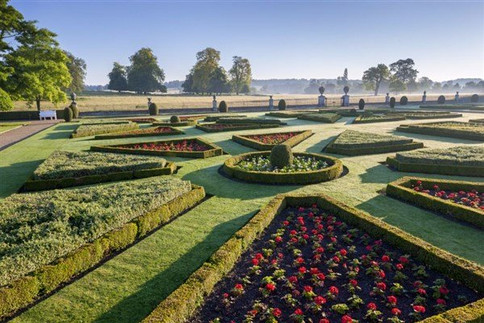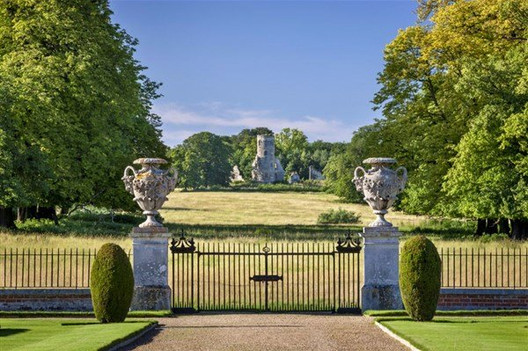
I visited Wimpole Hall the day after going to The Fitzwilliam Museum. It was the end of a hot September and the grounds were all burnt to a crisp. Wimpole Hall on the other hand, could not have been more radiant.
Wimpole Estate is a large estate containing Wimpole Hall, a country house located within Cambridgeshire, England, about 8 1 ⁄ 2 miles southwest of Cambridge. The house, begun in 1640 and is the largest house in Cambridgeshire, and its 3,000 acres of parkland and farmland are owned by the National Trust.

We begin with walking to the house, up a flight of stone steps topped with intricate Victorian Gothic lamps, to the entrance hall. The floor is tiled in an elaborate design lined with a greek border, great marble column's mark the entrances to the next rooms and we shall walk forwards to the inner hall that takes us to the Saloon.
The Saloon is large and rather grand with an opulent plaster ceiling design and a large gold chandelier. There is not an inch in the room that is not decorated, from the doors with their Georgian pediments centred around a statue to the ceiling high marble fireplace. Every room in this house is exquisitely detailed, not a single thing left un-gilded or carved and to describe them all I would surely run out of adjectives, so I will show you with pictures for as they always say "an image speaks a thousand words."

So we shall take a left and continue on in awe through the house, stopping to take in the church like majesty of the Yellow Drawing Room.

On to the Red Dining Room to the part of the house that lured us here most of all. The Book Room and the Library.
"Wimpole was once a centre of art and learning, Poets Alexander Pope, Lady Mary Wortley Montagu, Matthew Prior and Jonathon Swift were frequent visitors who valued Lord Harley's Extraordinary book collection."
The book room is a mini library painted a pale blue with plaster rose cameos on the alcoves, old leather bound books sit on bright white bookcase, gold curtains frame the windows that bathe the room in soft light and a beautiful old desk sits in front of the doors that once used to lead to a glass house conservatory full of exotics.


The conservatory sadly did not make it but it can just be seen at the back of this painting by Joesph Nash, titled 'A view of the book room at Wimpole Hall, Cambridgeshire'. Nash did many pictures of interior rooms in the manor houses of Britain including Windsor Castle. He also painted the interior of the Crystal Palace Exhibition.
On the right of the Book Room is the crown jewel of Wimpole Hall. The Library. The blinds are pulled down to protect the books from the light but that takes nothing away from the splendour of the room. The book cases rival the books in their beauty, both seeming to glow in the dim of the room.

Each book case had a gold letter on the top for it's section, two drinks globes sit patiently at the end of the room and the statues seem to stare off into the distance as though deep in thought. It is the most beautiful library I have ever been in and while we were only allowed to stand in the doorway just being able to stand and look upon those books beneath such a magnicifcent ceiling was breathtaking.
"An obsessive collector and great bibliophile, Lord Harley made his mansion at Wimpole one of the main centres of art and learning of the early Georgian age, and his Wimpole library expanded to house his vast collection of books. By the end of his life Harley had collected 50,000 printed books, 41,000 prints and 350,000 pamphlets."
While I'm sure we would both like to spend all of eternity in the Library there is much more that the house has to offer and so we shall reluctantly move on to the gallery where two musicians are playing amongst the pillars, one on a piano, the other with a flute, which is all very fitting for the setting.
Now through to the elegant south Drawing Room (because one drawing room, even a domed one, is never enough) and into The Ante Room (an antechamber, also known as ananteroom or ante-room, is a smaller room or vestibule serving as an entryway into a larger one) which brings us back to the entrance hall. One side down, one side to go.
We head back to the Saloon but this time we take a left through to the absinthe green Dining Room. I'm not going to even attempt to describe the lavishness of the ceiling or the luxuriance of the curtains, so I will let the pictures do it for me.
Now we come through a lamplit door to the part of the house that truly rivals the Library. The Staircase.

In shades of dusky pinks highlighted with cream and gold, there are statues on every floor atop custom plinths, plaster carvings and paintings.... it is truly exquisite.
If I spent time describing both the first floor, the staff quarters and all the other unusual and wonderful parts of the house we will never get to the gardens, so I will share the images and a few key highlights so we can hurry out to the flowers.
"Captain George and Mrs Elsie Bambridge bought Wimpole estate in 1938, with the Hall almost entirely empty of contents. Over the next 40 years the Bambridge's slowly furnished and decorated the house, seeking out pieces that were either once at Wimpole, or had strong connections to the estate or previous owners."
The most memorable part of the first floor is the bedroom whose bed touches the ceiling, Lord Chancellor's bedroom. The National Trust managed to retrieve the bed when it was sold at auction but the bed was so large that to get it back into the room they had to cut it in half and then rebuild it in the room. You really can't tell.
The other bedrooms and dressing rooms have more sensible beds, the windows look out across the gardens to the gates and towering in the distance is the folly which we shall look at more closely in a moment. At the end of the bedrooms is the print room that hold prints from the beautiful to the dramatic to the amusing.
Highlights such as the 1780s state bed, and the exquisite gilded sofas made especially to fit the curved walls of Sir John Soane’s Yellow Drawing Room, show how a grand country house would have looked in its heyday. Alongside the more formal rooms sit the cosier more personal spaces that make the house a home and reflect the Bambridges’ personalities and tastes. Look out for the collection of eighteenth and nineteenth century conversation pieces that decorate the drawing rooms, delicate French porcelain figures, and collections of carriage prints."

Under the grand staircase is the Soane Bathhouse. The designer Sir John Soane was inspired by Roman bath houses he’d seen at Pompeii in Italy. The bath required 2,199 gallons of water to fill it.
Deep inside the sober and formal mansion, and placed somewhat surprisingly adjacent to the Chapel, this eccentric and indulgent little space embodies a little-seen pleasure-loving side to the Yorke family.
Now on to the surprisingly adjacent chapel, a masterpiece of baroque.
Off of the entrance hall is Thornhill's chapel. James Thornhill was the leading English decorative painter of the early 18th century, known for painting the ceiling in the Painted Hall at Greenwich and the dome of St Pauls Cathedral, and he was also one of Edward Harley’s protégés. It took Thornhill three years to complete the painting of the Chapel and cost over £1,300.
Thornhill used a painting technique described as trompe l’oeil (French for ‘deceive the eye’) and on the large north wall the painting, which is directly onto the wall plaster, depicts statues of saints Gregory, Ambrose, Augustine and Jerome, the four theological teachers of the western church, who stand within arches.
Above them, putti (cherubs) hover, bearing items relating to the Crucifixion, including the cross, sponge on a reed, reed sceptre, holy grail and the crown of thorns. The paintings are remarkable for their bold shadows, the vigorous movement of the figures and subdued palette.
The painting on the east wall, above the altar, is actually a very large canvas painting and shows more putti raising a theatrical red curtain to reveal the Adoration of the Magi.
I think it's high time we went to the gardens. Garden and landscape designers have all left their mark on Wimpole in one form or another, including some well known names such as Charles Bridgeman, Capability Brown and Humprey Repton.
The Walled Garden
The 18th-century walled garden was constructed by William Eames and features Sir John Soane’s glasshouse. This is where volunteers nurture young plants for the vegetable plots and thousands of bedding plants for the parterre. We could not resist buying a beautiful forsythia.
Parterre
The parterre garden is a reflection of past glories in the North Park. This area of garden was lost for a century and restored in the 1990s. The parterre is in its full glory in the spring when there is a colourful display of red and yellow tulips and during the summer 12,000 salvia and pelargonium.
Pleasure Ground
In the 18th-century these grounds were where the family took evening strolls and enjoyed picnics. They contained many rare, exotic and unusual plants sourced from all over the world discovered by plant hunters who were widely travelled.
Whatever the weather Wimpole Hall manages to de dazzlingly sublime and I feel much like how Charles Ryder felt at Brideshead when he said "It was an aesthetic education to live within these walls" and a day spent at Wimpole rings true to these words. It is not to be missed.























































































































































































































































Comments